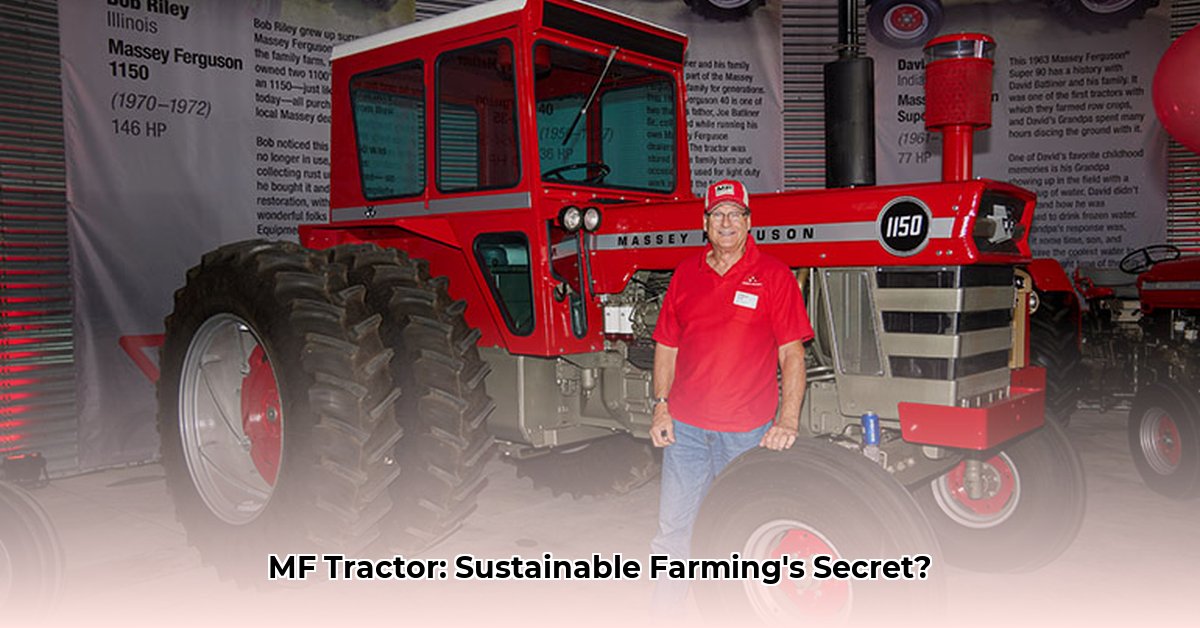
The 1970 Massey Ferguson MF 135 tractor—a stalwart of its era—wasn't designed with modern notions of sustainability in mind. Yet, its robust design and straightforward mechanics offer surprising lessons in resourcefulness and longevity, challenging our assumptions about environmentally friendly agriculture. This article explores the MF 135's impact, examining its strengths and weaknesses within the context of sustainable farming practices, both past and present. For more detailed specifications, check out the MF 135 specs.
A Timeless Design: Built to Last
The MF 135's enduring appeal stems from its simplicity. Unlike today's complex tractors, repairs rarely required specialized tools or technicians. This "fix-it-yourself" nature minimized waste, extended the tractor's lifespan, and reduced the environmental burden associated with frequent replacements and parts disposal. This straightforward approach is a stark contrast to modern, technologically advanced equipment that often has a shorter functional lifespan due to complex and costly repairs. This simplicity, however, did come with limitations in terms of precision and efficiency. How did fuel efficiency compare to its contemporaries?
Fuel Efficiency: A Different Era's Perspective
Fuel efficiency of the MF 135 must be considered within its historical context. While potentially comparable to other tractors of the 1970s, its consumption would be considered high by modern standards. The option of gasoline or diesel engines further complicated the picture, with diesel generally offering better fuel economy but creating more particulate matter pollution due to less stringent emission regulations. This highlights the evolution of both fuel efficiency and emission control technologies, underscoring the significant advancements made in recent decades to minimize the environmental impact of agricultural equipment. This leads us to a broader consideration of its overall environmental footprint.
The Environmental Footprint: A Bigger Picture
A truly comprehensive assessment of the MF 135's environmental impact requires a life-cycle assessment (LCA). This involves analyzing factors such as material sourcing (steel production's energy consumption and mining impacts), manufacturing processes (energy use and waste generation), and transportation throughout its operational life. Such in-depth analysis would provide a much more nuanced and accurate picture of its environmental implications compared to a simple comparison of fuel consumption with present-day models. This thorough approach is crucial for understanding the holistic environmental effects of agricultural machinery across different generations. What about the materials used in its construction?
Manufacturing and Materials: A Historical Context
The MF 135's construction predominantly relied on steel, a material with its own considerable environmental footprint. Consider the energy required for steel refinement, the extraction processes, and the associated emissions. These factors, coupled with the manufacturing processes of the time, are vastly different from today's standards. Understanding the environmental costs associated with the sourcing and manufacture of its components is essential for a complete picture of its impact. But how does this legacy relate to modern sustainable agriculture?
The MF 135 in Modern Sustainable Agriculture
The MF 135’s inherent limitations become apparent when considering current sustainable agricultural practices. Lacking modern technologies like GPS guidance, variable-rate fertilization, or precision planting systems, it falls short in optimizing resource use and minimizing environmental impact. Its application in modern farming is therefore limited, although its durability and simplicity might find niches in specialized situations, such as smaller farms or regenerative agriculture systems where its ease of repair and robustness become more valuable than its technological limitations. How can we adapt this classic tractor for a more sustainable future?
How to Adapt a Massey Ferguson 135 for Modern Sustainable Farming
While the MF 135 might not be a leader in sustainable technology, its restoration and adaptation can contribute to a greener future through mindful upgrades and repurposing. Restoring a MF 135 is not merely about preserving history but engaging in a sustainable act in itself. Reusing existing machinery reduces the demand for new production, thereby decreasing the associated environmental impact and utilizing existing resources efficiently.
Revitalizing a Classic: Restoration and Upgrades
Restoring a MF 135 requires a systematic approach:
- Assessment and Planning: A thorough inspection and identification of required repairs and upgrades are essential to allocate resources effectively.
- Sourcing Parts: Finding replacement parts can be challenging. Online tractor communities and resourceful scavenging are often necessary.
- Mechanical Overhaul: A comprehensive mechanical overhaul, including engine repair, transmission maintenance, and hydraulic system checks, is crucial. Upgrading components with modern, yet compatible, substitutes can also improve functionality and efficiency.
- Modernization: Targeted upgrades, like efficient LED lighting or a higher-output alternator, can increase functionality without compromising the tractor's originality.
Balancing Tradition and Modernity: The Alternator Upgrade
Upgrading the alternator illustrates the trade-off between authenticity and efficiency. While the original alternator maintains historical integrity, a modern alternative might significantly boost electrical output, allowing for the addition of modern technologies.
Key Takeaways:
- Reduced Environmental Footprint: Restoration reduces the need for new manufacturing.
- Enhanced Fuel Efficiency: Maintenance optimizes fuel consumption.
- Preservation of Skills: Restoration fosters the preservation of mechanical knowledge.
- Adaptable for Modern Practices: Upgrades allow integration with modern sustainable farming.
- Cost-Effective Solution: Often a more affordable alternative to new equipment.
The 1970 Massey Ferguson MF 135, while a product of its time, highlights the evolving nature of sustainability. Its story underscores the value of durability, repairability, and mindful adaptation in creating a more environmentally responsible agricultural future.